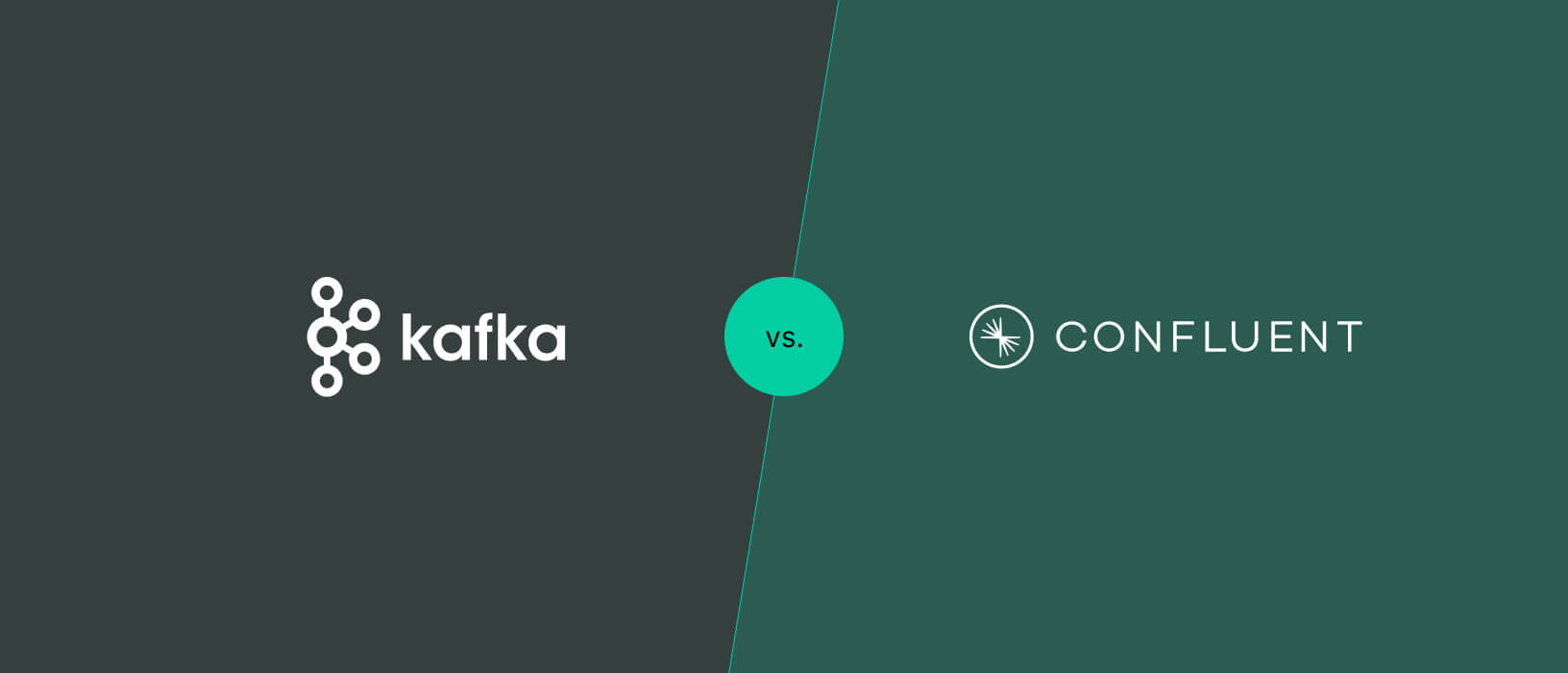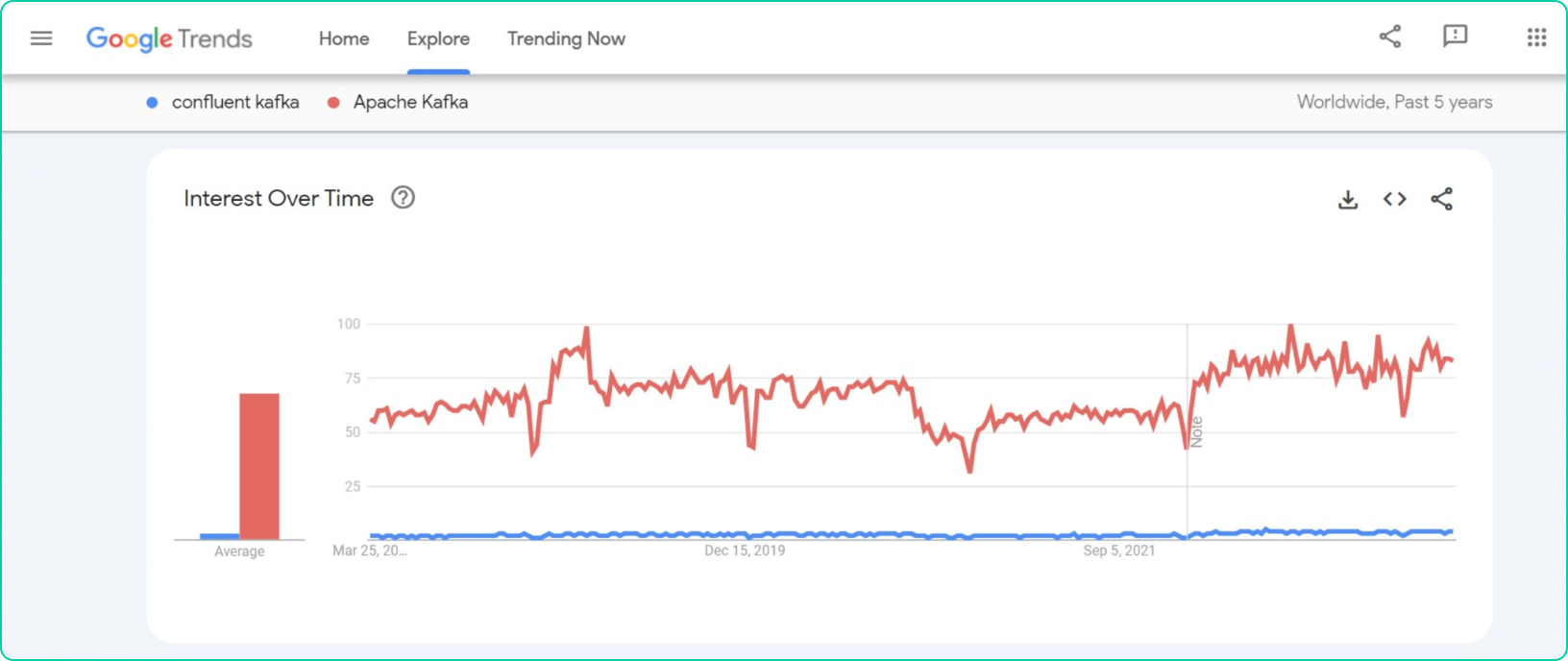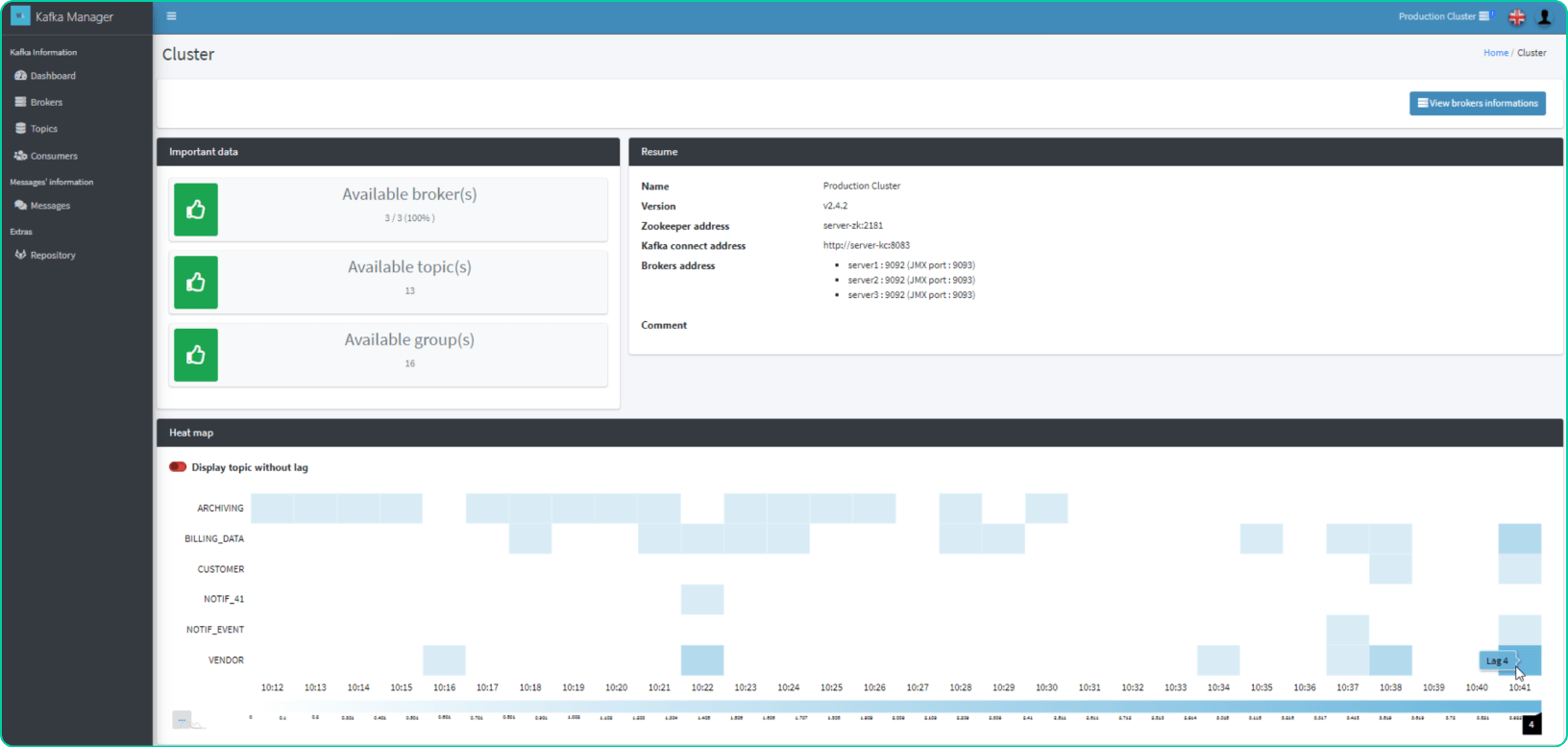
Confluent Kafka vs Apache Kafka: Experts comparison
Apache Kafka vs Confluent Kafka: Most thorough comparison

As a popular pub-sub management platform and open source message broker, Apache Kafka is widely used in the Big Data industry while Confluent, being a data streaming platform based on Apache Kafka also provides other additional technologies. Although both platforms include essential features that power data systems, Apache’s framework are mainly used in data operations while Confluent Kafka is used in data processing.
In this article, we will review key parameters, discuss some of the important features and compare Apache Kafka with Confluent Kafka.
What is Confluent Kafka?
With an infrastructure based on Apache Kafka, Confluent Kafka is a distributed streaming platform created to offer a highly scalable and dependable data pipeline for real-time data processing. To assist organizations in creating real-time data applications, it provides sophisticated capabilities such as message durability, data integration, stream processing, and data analytics. Confluent Kafka is powered by a user-friendly interface that enables the development of event-driven microservices, IoT applications, and other real-time use cases. Both developers and data engineers choose Confluent platform because of its open source nature and a robust ecosystem of connections and tools.
What is Apache Kafka?
Apache Kafka open source distributed streaming technology enables companies to instantly handle and analyze huge amounts of data. It serves as a message system for applications, facilitating seamless data integration and communication between different sources and systems. Kafka is the best solution for handling high-volume data streams because it is scalable, fault-tolerant, and highly available. Its architecture consists of topics, partitions, and brokers, which makes it possible to store, retrieve, and process data effectively. Kafka is a preferred option for developing real-time data pipelines, stream processing, and event-driven microservices because of its extensive ecosystem of additional pre built connectors, libraries, and tools.
Learn more about it here — What is Apache Kafka?
Confluent Kafka vs Apache Kafka
Use cases
The availability of additional features and tools that come with Confluent is one of the main distinctions between Confluent Kafka and Apache Kafka. Confluent Schema Registry, Confluent Control Center, and Confluent Connect are some of these features and together, they offer data governance, monitoring, and integration capabilities. Considering these, Confluent Kafka, being a fully equipped platform may be more suitable for use cases at the enterprise level because of its improvements.
The degree of support provided is another significant variation. Kafka is supported commercially by Confluent Kafka, but Apache Kafka is an open source project that depends on user support. For companies that need high availability, dependability, and prompt issue resolution, this support is especially crucial.
You can read more about use cases of Apache Kafka in our article — The Many Use Cases Of Apache Kafka®: When To Use & Not Use It
Generally, Confluent Kafka’s sophisticated capabilities and support are not necessary for smaller-scale installations using Apache Kafka, which is adequate for such. Confluent Kafka works best for complex, mission-critical applications that need cutting-edge capabilities, tools, and support.
Popularity
The de facto standard for real-time data streaming and processing has been generally accepted as Apache Kafka, and this acceptance only continues to increase. Google Trends data shows that over the previous five years, online searches for Apache Kafka have steadily increased. Moreover, Apache Kafka is widely utilized in sectors including banking, healthcare, and technology. It also has a sizable and active community of contributors and users.
However, Confluent Kafka is a more modern platform that has grown in popularity recently because of its enterprise-level capabilities and support. Confluent Kafka has swiftly emerged as a top option for companies needing extensive data integration, governance, and monitoring features, even though it may not be as well-known as Apache Kafka. Confluent Kafka has been adopted by numerous firms, including Airbnb, Lyft, and Netflix, demonstrating its rising popularity. Confluent Kafka is becoming more and more well-liked even though Apache Kafka is still the more well-known platform thanks to its extensive feature set and support.

Technology
Confluent Kafka is a commercial release of Apache Kafka that includes additional enterprise capabilities like multi-datacenter replication, schema management, and security enhancements. However, building real-time data pipelines and streaming applications can all be done using Apache Kafka. Confluent Kafka has enterprise-grade features that are absent from Apache Kafka, which is a significant distinction between the two platforms. But, in terms of customization and implementation, Apache Kafka offers more benefits. Moreover, Confluent Kafka offers support and services to assist with the setup and maintenance of the platform, while Apache Kafka relies on community support. The choice between Confluent Kafka vs. Apache Kafka should be based on the organization’s unique needs and expectations.
Performance
In terms of platform performance, both Confluent Kafka and Apache Kafka are known for their ability to handle large amounts of data with low latency and high throughput. However, Confluent Kafka offers additional performance improvements through its enterprise features such as multi-datacenter replication and advanced caching mechanisms. These features allow Confluent Kafka to achieve even faster data processing and delivery times, which can be critical for high-performance applications. Apache Kafka, offers more flexibility in terms of hardware and network configurations, allowing for fine-tuning of performance based on specific needs.
Pricing
There are no license fees or additional expenses associated with using Apache Kafka because it is open source and free to use. Organizations will nevertheless need to set aside funds for your staff to implement and manage the platform’s hardware and infrastructure. Conversely, Confluent Kafka has a subscription-based pricing structure. Access to extra enterprise capabilities, support services, and training materials is made available through this subscription, which aids businesses in streamlining their Kafka installations and enhancing operational effectiveness. A Confluent Kafka platform subscription can be somewhat expensive for large-scale deployments due to the size and complexity of the deployment and Apache Kafka may appear to be the more cost-effective solution for the business.
Features
Both Apache Kafka and Confluent Kafka offer robust data streaming and processing capabilities, but there are some key differences between the two platforms. Apache Kafka is an open source message broker that provides a core set of features, including low latency, fault-tolerant, and high throughput processing of streaming data. Confluent Kafka platform builds on these core Apache Kafka features by adding additional pre-built connectors, such as the REST Proxy and Schema Registry, as well as advanced tools for managing and deploying Kafka clusters, such as Confluent Control Center. Unlike Apache Kafka, Confluent Kafka is available both as an open source platform under the Confluent Community License and as a fee-based enterprise license, which provides additional features and support services. Additionally, Confluent Kafka offers Confluent Cloud, a fully-managed service for deploying and running event streaming platforms on cloud providers.
While both platforms are suitable for companies looking to build robust event streaming and data processing pipelines, Confluent Kafka’s offerings may be more attractive to companies that require additional features, support, and manageability tools.
Licensing
As aforementioned, Apache Kafka is an open source platform that is available for free, and there are no licensing fees associated with its use. However, users are responsible for maintaining and deploying their own Kafka servers, as well as any additional tools or technologies they may require. In contrast, Confluent Kafka is also built on the core Apache Kafka product, but it offers additional features and support services through its fee based enterprise license. Confluent’s enterprise license allows users to access additional technologies and features, including Confluent Control Center for managing Kafka clusters, as well as additional pre-built connectors. Confluent also offers a fully-managed service, Confluent Cloud, which allows users to deploy and run event streaming platforms on cloud providers. For those who prefer to use the open source version of Confluent Kafka, the Confluent Community License is available, which provides access to the Confluent Kafka platform with some added limitations and following restrictions.
While Apache Kafka may be a good option for those who want a free and open source data streaming platform, Confluent Kafka’s enterprise license and additional features may be more appealing to businesses that require more advanced features, support, and manageability tools.
Ease of Use
Confluent Kafka has a reputation for being a more user-friendly platform compared to Apache Kafka. Many user reviews highlight that Confluent’s additional pre-built connectors and managed service offerings make it easier to deploy and maintain Kafka clusters. Additionally, Confluent’s enterprise license provides users with more support and added features that help manage and scale their event streaming platform with ease. While Apache Kafka is a robust and efficient open source message broker, it requires more technical expertise and knowledge to manage and scale but some users may prefer the flexibility of Apache Kafka’s open source platform.
Support and services
According to multiple user reviews, Confluent Kafka provides superior support and services compared to Apache Kafka. Confluent provides a managed service referred to as Confluent Cloud that is made to handle data streaming, event processing, and cloud storage. They also offer other features and tools, including REST Proxy, Schema Registry, and Kafka Connectors. Businesses may benefit from Confluent’s enterprise license, which includes high-availability clusters and extra technologies. To assist businesses in efficiently managing their Confluent instances, they also provide support and training services. On the other hand, Apache Kafka provides a free-to-use, open source data streaming platform that does not have any additional restrictions. There is no formal support or managed service offered; instead, the community offers support through mailing lists and forums.
Community
Confluent Kafka’s community is substantially smaller than that of Apache Kafka. Being an open source message broker project, Apache Kafka is available for usage and development by anyone. Due to its open source nature and the huge and active developer community that constantly updates and adds new features to the platform, it is the preferred option for businesses that value the flexibility of an open source platform. This also means that there are plenty of resources and documentation available for users to learn from and troubleshoot any issues they may face. Confluent Kafka is fairly new to the industry and has a smaller community because it is a commercial platform even though it was created on the Apache Kafka infrastructure. Only individuals with a Confluent Community License or those who have paid for an enterprise license are eligible to join its community. Apache Kafka has a larger community and a plethora of information available, making it a more appealing alternative for businesses looking for community assistance although Confluent has its own set of resources and documentation available for users.
Integration
Confluent Kafka has the advantage here. It provides technology and pre-built interfaces that enable smooth integration with other data processing systems. Confluent Schema Registry, Confluent Control Center, and Confluent REST Proxy are among the products offered by Confluent Kafka. These tools can be used to set up, maintain, and keep an eye on Kafka clusters, which offer fault tolerance, high availability, and quick data streaming. Confluent also offers Confluent Cloud, a fully-managed solution on a public cloud provider that makes jobs involving stream processing and data engineering simpler. Additionally, Confluent Kafka offers an enterprise license with extra tools and functionality to support businesses with sophisticated data processing needs. Conversely, the main Apache Kafka product is available on the open source Apache platform. Although it offers the same degree of advanced technology and features as Confluent Kafka, it does not offer pre-built connectors or compatibility for as many platforms.
Security
Both Apache Kafka and Confluent Kafka have strong security protections, however, Confluent Kafka has more features and capabilities that make it a more secure choice. Confluent Kafka, for instance, offers authentication and authorization procedures, as well as encryption in transit and at rest, all of which are also accessible in Apache Kafka. To add to these, Confluent Kafka additionally provides audit logging and role-based access control (RBAC), which are unavailable in Apache Kafka. Confluent Kafka also offers a schema registry that aids in data compatibility and validation, making it simpler to secure data transport. Moreover, Confluent provides a managed cloud service, not offered by Apache Kafka, that offers businesses a more secure environment and simplified management. Confluent Kafka offers stronger security features and capabilities under closer inspection, making it the preferable choice for businesses searching for a more secure data streaming platform.
Monitoring
Strong monitoring systems are provided on both Confluent Kafka and Apache Kafka. However, there are some differences between the two. Kafka Manager, a web-based utility provided by Apache Kafka, enables the monitoring of Kafka clusters and their topics.

Source: https://blog.worldline.tech/2021/11/10/kafka-manager.html
The open source program offers functionality for real-time alerting and monitoring. Nevertheless, Kafka Management must be installed separately because it is not a part of the Apache Kafka core product. Contrarily, Confluent Kafka offers built-in monitoring via its Confluent Control Center. It has a web-based user interface that enables users to keep an eye on brokers, subjects, and clusters in real time. The Confluent Control Center may be used to configure and maintain cluster setups and also provides features like alerting and metrics.
Although Apache Kafka’s Kafka Manager is a good choice for individuals searching for a free and open source monitoring solution, DoubleCloud Managed Service for Apache Kafka can also help users maximize the platform’s features.
Deployment
Both Confluent Kafka and Apache Kafka provide a variety of tools and deployment options for their platforms. Since Apache Kafka is an open source platform, setting it up is not too difficult. It can be set up locally, on the cloud, or through a managed service offered by cloud service providers like DoubleCloud. Confluent Cloud, a managed service that may be used to deploy Kafka on well-known cloud providers, is one of the extra technologies that Confluent Kafka offers that can simplify deployment. Confluent Kafka also provides more pre-built connections as well as a schema registry for improving data management, which facilitates deployment and increases efficiency. The enterprise license is required to access Confluent Kafka’s features, although this can be costly for some companies.
Ecosystem
The basic Apache product is a part of the Apache Kafka Ecosystem. Apache Kafka is a stand-alone open source message broker, in contrast to Confluent Kafka, which also provides extra technologies and functionality including the Confluent Kafka platform, Schema Registry, and REST Proxy. It offers a wide selection of pre-built connections and tools to make the process of integrating data with other services simpler. With replication across Kafka clusters, it also provides strong fault tolerance, high availability, and security features. Contrarily, Confluent Kafka offers a managed service for event streaming and, through the usage of its business license technology, provides more corporate-focused functionality. Confluent Kafka’s solutions are best suited for data engineering, stream processing, and deployment on a cloud provider, whereas Apache Kafka is a widely-liked option for businesses that wish to manage their use cases.
Connectors
Both Confluent Kafka and Apache Kafka provide a wide range of pre-built connectors that let you connect to a wide range of data sources and programs. The connectors on the two platforms do, however, differ in a few ways. In contrast to Apache Kafka, Confluent Kafka provides more pre-built connectors outside of the Apache Kafka core offering. Confluent’s managed service, Confluent Cloud, or its enterprise license both provide access to these connectors. A REST Proxy and a Schema Registry are only two more technologies that Confluent Kafka’s solutions feature that may be helpful in a data engineering scenario. The Confluent Community License mandates that any additional technology developed utilizing Confluent Kafka’s open source platform must be made freely available to the community, therefore these extra features come with additional restrictions. The decision between Confluent Kafka and Apache Kafka connectors will ultimately be based on the particular requirements of a business or project. Additionally, DoubleCloud connectors can also come in handy when deploying your project.
Comparison table
|
Comparison |
Apache Kafka |
Confluent Kafka |
|
Use cases |
Real-time stream processing, messaging, log aggregation, and event sourcing. |
Same as Apache Kafka, but also includes advanced features for enterprise use cases like multi-datacenter replication, data governance, and security. |
|
Popularity |
Widely used by developers and organizations of all sizes. |
Popular among large enterprises, especially those that require advanced features and support services. |
|
Technology |
open source distributed event streaming platform. |
Built on top of Apache Kafka and provides a more comprehensive platform for event streaming with additional features and tools. |
|
Performance |
High throughput, low latency, and fault-tolerant. |
Same as Apache Kafka, but also includes additional performance optimizations and monitoring tools. |
|
Pricing |
Free and open source. |
Offers both a free Community edition and a paid Enterprise edition with additional features and support services. |
|
Features |
Core features include pub/sub messaging, stream processing, and fault-tolerant storage. |
Adds additional features like schema registry, connectors, ksqlDB, multi-datacenter replication, and data governance tools. |
|
Licensing |
Apache License 2.0 |
Confluent Community License (based on Apache License 2.0) and Confluent Enterprise License. |
|
Ease of Use |
Requires some expertise to set up and configure, but has a relatively simple API for developers. |
Provides additional tools and services to simplify deployment, configuration, and management. |
|
Support and Services |
Community support available, but no formal support from the Apache Kafka project. |
Offers enterprise-grade support services, training, and consulting. |
|
Community |
Large and active open source community. |
Smaller community, but focused on enterprise use cases and features. |
|
Integration |
Integrates with a wide variety of data sources and processing frameworks. |
Same as Apache Kafka, but also includes additional integrations with Confluent’s proprietary tools and services. |
|
Security |
Supports SSL/TLS encryption, authentication, and authorization. |
Same as Apache Kafka, but also includes additional security features like data encryption, audit logs, and fine-grained access control. |
|
Monitoring |
Provides basic monitoring through JMX and command-line tools. |
Includes additional monitoring tools and dashboards through Confluent Control Center. |
|
Deployment |
Can be deployed on-premises or in the cloud. |
Same as Apache Kafka, but also includes additional deployment options like Confluent Cloud. |
|
Ecosystem |
Large and growing ecosystem of third-party tools and services. |
Same as Apache Kafka, but also includes additional tools and services from Confluent. |
|
Connectors |
Provides a library of connectors for integrating with various data sources and sinks. |
Same as Apache Kafka, but also includes additional connectors developed by Confluent. |
Pros and cons of Apache Kafka
Here are some of the advantages and disadvantages of using the Apache Kafka messaging broker for your project.
Pros
-
High throughput: Kafka is the best choice for use cases that call for real-time data streaming since it can handle millions of messages per second with very little delay.
-
Scalability: The horizontal scalability of Kafka makes it simple for users to add or remove nodes from the cluster in response to shifting demand.
-
Fault-tolerant: Kafka is built to be fault-tolerant, so it can keep running even if some nodes stop working or some messages go missing.
-
Flexibility: Kafka is compatible with a large number of data sources and has a wide range of applications, including messaging, log aggregation, and real-time analytics.
Cons
-
Complexity: Kafka can be difficult to set up and install, and managing it well takes extensive knowledge.
-
Cost: Although the Apache Kafka product’s core is open source and free to use, many of the supplemental technologies and features offered by Confluent, the main supplier of Kafka services, are only accessible through fee-based corporate licenses.
-
Additional technologies: Users may need to use additional technologies, such as the Confluent Schema Registry and REST Proxy, to get the most out of Kafka, which can complicate the system.
-
Maintenance: Kafka requires continual maintenance to maintain good availability and performance, much like any distributed system. For firms lacking strong technological resources, this can be time-consuming and expensive.
Pros and cons of Confluent
Here are some of the advantages and disadvantages of choosing Confluent Kafka for your project.
Pros
-
Pre-built connectors: Around 100 pre-built connectors from Confluent Kafka make it simple to integrate data with a variety of systems, such as databases, cloud services, and IoT gadgets.
-
Advanced features: Confluent Kafka offers extra features including Confluent Schema Registry, Confluent Control Center, and Confluent REST Proxy that expand Apache Kafka’s capability.
-
Managed services: With Apache Kafka, connectors, and tools included, Confluent Cloud is a managed service that offers a fully managed event streaming platform on a pay-as-you-go basis.
-
High Availability: Disaster recovery, fault tolerance, and high availability are all features that come standard with Confluent Kafka.
Cons
-
Added limitations: Other restrictions associated with Confluent Kafka’s capabilities and technologies include vendor lock-in, increased complexity, and reliance on Confluent’s roadmap.
-
Cost: Enterprise customers of Confluent Kafka must pay a charge to use more features, tools, and support because it is a commercial product.
-
Complexity: The sophisticated tools and features of Confluent Kafka can be difficult to deploy, configure, and maintain since they are complex.
-
Dependency on additional technologies: Confluent Kafka requires additional technologies, like ZooKeeper, to function, which can make the deployment process more complicated overall.
How DoubleCloud helps you with Apache Kafka?
As a cloud-native platform that provides managed services for Apache Kafka, DoubleCloud allows users and companies to streamline the deployment and management of their data-streaming infrastructure. With DoubleCloud, you can quickly and easily provision Kafka clusters on your preferred cloud provider, configure them to meet your specific needs, and then let DoubleCloud handle the ongoing management and maintenance. This takes the burden of managing and scaling Kafka off of your internal IT team, allowing them to focus on other critical business needs.
DoubleCloud provides a user-friendly interface that allows you to easily manage your Kafka clusters, whether you need to scale up or down, monitor performance, or optimize your configuration settings. DoubleCloud also includes a range of advanced features, including automatic failover, data replication, and built-in security, ensuring that your Kafka clusters are always available, reliable, and secure. Additionally, DoubleCloud’s managed Kafka service is highly flexible, allowing you to easily integrate Kafka with other tools and services that you may be using in your data streaming infrastructure.
Read more on the significant advantages of managed Kafka on DoubleCloud.
Final Words: Confluent Kafka vs Apache Kafka: What to choose?
When deciding between Confluent Kafka and Apache Kafka, it is important to consider the unique features of each platform. While both platforms offer free and open source message brokers, Confluent Kafka provides additional pre-built connectors and an enterprise license for added features and support. On the other hand, Apache Kafka is a core product with no added limitations or restrictions. However, managing Kafka clusters can be complex and time-consuming, which is where services like DoubleCloud’s Managed Kafka come in to help. Ultimately, the choice between Confluent Kafka and Apache Kafka will depend on the specific needs and priorities of the company or organization using the data streaming platform.
Frequently asked questions (FAQ)
What companies use Apache Kafka?
What companies use Apache Kafka?
Many businesses, including LinkedIn, Uber, Netflix, Airbnb, Twitter, and many more, use Apache Kafka. As a popular option for large-scale data streaming and processing requirements, Apache Kafka is widely used by businesses in a variety of industries.
What is Apache Kafka good for?
What is Apache Kafka good for?
Is Apache Kafka free?
Is Apache Kafka free?
Start your trial today



